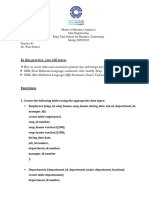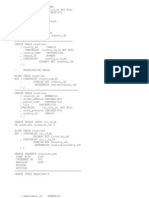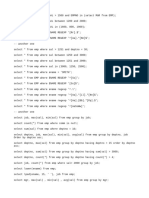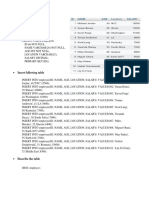0 ratings0% found this document useful (0 votes)
11 viewsSQL Part 4 Practice Questions and Answers
The document outlines the SQL commands to create and manage an Employees table with various constraints, including primary keys, foreign keys, unique constraints, and check constraints. It also details the creation of related tables such as Departments, Projects, Cities, and Bonuses, along with rules to ensure data integrity and specific conditions for employee attributes. Additionally, it includes commands to set default values and restrict certain fields to predefined options.
Uploaded by
Priyanshu JakharCopyright
© © All Rights Reserved
We take content rights seriously. If you suspect this is your content, claim it here.
Available Formats
Download as DOCX, PDF, TXT or read online on Scribd
0 ratings0% found this document useful (0 votes)
11 viewsSQL Part 4 Practice Questions and Answers
The document outlines the SQL commands to create and manage an Employees table with various constraints, including primary keys, foreign keys, unique constraints, and check constraints. It also details the creation of related tables such as Departments, Projects, Cities, and Bonuses, along with rules to ensure data integrity and specific conditions for employee attributes. Additionally, it includes commands to set default values and restrict certain fields to predefined options.
Uploaded by
Priyanshu JakharCopyright
© © All Rights Reserved
We take content rights seriously. If you suspect this is your content, claim it here.
Available Formats
Download as DOCX, PDF, TXT or read online on Scribd
You are on page 1/ 4
1.
Create the Employees table with constraints
CREATE TABLE Employees (
EmployeeID INT PRIMARY KEY, -- PRIMARY KEY constraint
FirstName VARCHAR(50) NOT NULL, -- NOT NULL constraint
LastName VARCHAR(50) NOT NULL, -- NOT NULL constraint
Department VARCHAR(50) NOT NULL, -- NOT NULL constraint
Salary INT CHECK (Salary > 50000 AND Salary < 100000), -- CHECK constraint
HireDate DATE NOT NULL, -- NOT NULL constraint
City VARCHAR(50) DEFAULT 'Unknown' -- DEFAULT constraint
);
2. Insert records while satisfying constraints
INSERT INTO Employees (EmployeeID, FirstName, LastName, Department, Salary,
HireDate, City)
VALUES
(1, 'John', 'Doe', 'Finance', 75000, '2020-01-15', 'New York');
3. Ensure department names are unique
ALTER TABLE Employees
ADD CONSTRAINT Unique_Department UNIQUE (Department);
4. Add a foreign key relationship to a new Departments table
CREATE TABLE Departments (
DepartmentID INT PRIMARY KEY, -- Primary key for Departments table
DepartmentName VARCHAR(50) UNIQUE NOT NULL -- UNIQUE and NOT NULL
constraint
);
ALTER TABLE Employees
ADD DepartmentID INT;
ALTER TABLE Employees
ADD CONSTRAINT FK_Department FOREIGN KEY (DepartmentID) REFERENCES
Departments(DepartmentID);
5. Ensure EmployeeID is unique (redundant with PRIMARY KEY for
demonstration)
ALTER TABLE Employees
ADD CONSTRAINT Unique_EmployeeID UNIQUE (EmployeeID);
6. Add a check constraint on HireDate
ALTER TABLE Employees
ADD CONSTRAINT Check_HireDate CHECK (HireDate >= '2000-01-01');
7. Default city for employees not explicitly assigned
ALTER TABLE Employees
ALTER COLUMN City SET DEFAULT 'Unknown';
8. Ensure salary is a positive number
ALTER TABLE Employees
ADD CONSTRAINT Check_Salary_Positive CHECK (Salary > 0);
ALTER TABLE Employees
ADD CONSTRAINT Unique_FullName UNIQUE (FirstName, LastName);
10. Restrict employees to specific cities only
ALTER TABLE Employees
ADD CONSTRAINT Check_City CHECK (City IN ('New York', 'San Francisco', 'Los
Angeles', 'Chicago', 'Houston', 'Seattle', 'Phoenix', 'Boston', 'Denver',
'Austin', 'Dallas', 'San Diego'));
11. Create an index on Department for faster queries
CREATE UNIQUE INDEX idx_Department ON Employees(Department);
12. Create a table for Projects with a foreign key to Employees
CREATE TABLE Projects (
ProjectID INT PRIMARY KEY,
ProjectName VARCHAR(100) NOT NULL,
EmployeeID INT,
FOREIGN KEY (EmployeeID) REFERENCES Employees(EmployeeID)
);
13. Add a default salary if not provided
ALTER TABLE Employees
ALTER COLUMN Salary SET DEFAULT 60000;
14. Ensure names are not empty strings
ALTER TABLE Employees
ADD CONSTRAINT Check_Name_Not_Empty CHECK (FirstName <> '' AND LastName <>
'');
15. Add a foreign key to a Cities table
CREATE TABLE Cities (
CityID INT PRIMARY KEY,
CityName VARCHAR(50) UNIQUE NOT NULL
);
ALTER TABLE Employees
ADD CityID INT;
ALTER TABLE Employees
ADD CONSTRAINT FK_City FOREIGN KEY (CityID) REFERENCES Cities(CityID);
16. Set a default hire date
ALTER TABLE Employees
ALTER COLUMN HireDate SET DEFAULT GETDATE(); -- For SQL Server
-- Use CURRENT_DATE for PostgreSQL or MySQL
17. Restrict department names to specific values
ALTER TABLE Departments
ADD CONSTRAINT Check_DepartmentName CHECK (DepartmentName IN ('Finance', 'IT',
'HR', 'Marketing'));
18. Ensure no duplicate combinations of EmployeeID and CityID
ALTER TABLE Employees
ADD CONSTRAINT Unique_Employee_City UNIQUE (EmployeeID, CityID);
19. Create a Bonuses table with constraints and foreign keys
CREATE TABLE Bonuses (
BonusID INT PRIMARY KEY,
EmployeeID INT NOT NULL,
BonusAmount INT CHECK (BonusAmount >= 0),
FOREIGN KEY (EmployeeID) REFERENCES Employees(EmployeeID)
);
20. Ensure all employees in IT have a salary above 80,000
ALTER TABLE Employees
ADD CONSTRAINT Check_IT_Salary CHECK (Department <> 'IT' OR Salary >= 80000);
You might also like
- W450700 Greer MicroGuard Application Loader ManualNo ratings yetW450700 Greer MicroGuard Application Loader Manual20 pages
- Unique, Primary Key, Foreign Key, Check, Not Null, Default ValueNo ratings yetUnique, Primary Key, Foreign Key, Check, Not Null, Default Value7 pages
- Query List:: A. B. C. D. E. F. G. A. B. C. D. E. 3-4 - A. B. C. D. E. 5 - 6 - 7 - 8 - A. B. A. B. C. D. 10 - 11 - A. B. C0% (1)Query List:: A. B. C. D. E. F. G. A. B. C. D. E. 3-4 - A. B. C. D. E. 5 - 6 - 7 - 8 - A. B. A. B. C. D. 10 - 11 - A. B. C8 pages
- NOT Like: Check Whether The Max - Salary Amount Exceeding The Upper Limit 25000No ratings yetNOT Like: Check Whether The Max - Salary Amount Exceeding The Upper Limit 250004 pages
- This Study Resource Was: Aim: To Know How The Constraints Are Used To Make Table Is ConsistentNo ratings yetThis Study Resource Was: Aim: To Know How The Constraints Are Used To Make Table Is Consistent6 pages
- تكليف قواعد البيانات مهند علي علي علي سعد الاخيرNo ratings yetتكليف قواعد البيانات مهند علي علي علي سعد الاخير2 pages
- School of Computer Science and Engineering: CSE2004 - Database Management Systems Lab Cycle Sheet - I100% (2)School of Computer Science and Engineering: CSE2004 - Database Management Systems Lab Cycle Sheet - I21 pages
- Lab-9# Experiment 9_ Types of Constraints ## __Lab Objective___ This Lab Aims to Equip Students With Practical Skills in Implementing and Managing Various Types of Constraints in SQL. Students Will Learn How to Enforce Data Integrity and ANo ratings yetLab-9# Experiment 9_ Types of Constraints ## __Lab Objective___ This Lab Aims to Equip Students With Practical Skills in Implementing and Managing Various Types of Constraints in SQL. Students Will Learn How to Enforce Data Integrity and A4 pages
- Name: Vinayak Nagar Reg - No.: 21MCA0015 Subject: Database Technology Topic: Assignment-1No ratings yetName: Vinayak Nagar Reg - No.: 21MCA0015 Subject: Database Technology Topic: Assignment-177 pages
- CSE2004-Data Base Management Systems: Course: CSE2004-DBMSLAB B.TechNo ratings yetCSE2004-Data Base Management Systems: Course: CSE2004-DBMSLAB B.Tech3 pages
- Adding Columns: Modifying Columns: Dropping Columns: Marking Columns As Unused: Renaming Columns: Marking The Table As Read-OnlyNo ratings yetAdding Columns: Modifying Columns: Dropping Columns: Marking Columns As Unused: Renaming Columns: Marking The Table As Read-Only1 page
- Department OF Computer Science and Engineering: Data Base Management System LaboratoryNo ratings yetDepartment OF Computer Science and Engineering: Data Base Management System Laboratory37 pages
- FULL Script Human Resources For Oracle DatabaseNo ratings yetFULL Script Human Resources For Oracle Database65 pages
- Advance Spreadsheet Skills: By: Faith R. Mayor Grade 11 HUMSS-HOPENo ratings yetAdvance Spreadsheet Skills: By: Faith R. Mayor Grade 11 HUMSS-HOPE20 pages
- Ccc Ts 101 Digital Key r3 1.2.3 ApprovedNo ratings yetCcc Ts 101 Digital Key r3 1.2.3 Approved542 pages
- HP Client Automation Enterprise User Guide - Windows and Linux.No ratings yetHP Client Automation Enterprise User Guide - Windows and Linux.485 pages
- Binary To Decimal and Decimal To Binary ConversionNo ratings yetBinary To Decimal and Decimal To Binary Conversion4 pages
- Artificial Intelligence For 5G and Beyond 5G: Implementations, Algorithms, and OptimizationsNo ratings yetArtificial Intelligence For 5G and Beyond 5G: Implementations, Algorithms, and Optimizations15 pages
- Unit 1: Subtopic: Introduction To World Wide Web - Internet OperationNo ratings yetUnit 1: Subtopic: Introduction To World Wide Web - Internet Operation17 pages
- UD32801B - Wired Handheld Code Reader User Manual - V2.2.0 - 20230403 - 6612No ratings yetUD32801B - Wired Handheld Code Reader User Manual - V2.2.0 - 20230403 - 661285 pages
- TEST 3 KK Data File Online Learning Spring 2021 TheoryNo ratings yetTEST 3 KK Data File Online Learning Spring 2021 Theory3 pages

























































































